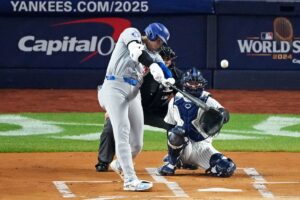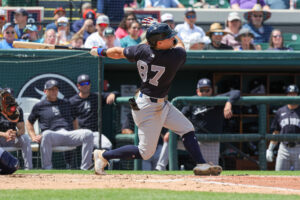It is no secret that the Kansas City Royals are rebuilding following their run of success in the middle of the 2010s decade. Since 2017, seasons of 82, 104, and 103 losses have put the Royals draft team in position to select high-end talent.
Their top-three prospects, Bobby Witt Jr., Brady Singer, and Daniel Lynch, are all top-100 prospects, according to MLB.com. Those three men, as well as seven of their top-ten prospects were drafted in 2018 or 2019. The 2020 Royals draft class looks to add to that crop of players, as Dayton Moore loaded up on college pitching.
Overall, the Royals draft class is comprised of six selections. Four of those picks are pitchers, and three of those pitchers are college pitchers. Meanwhile, the two position players drafted are both college players.
Round One, Pick Four: LHP Asa Lacy
The Royals may have been handed a gift when Asa Lacy fell into their laps in the first round. He was considered a lock to go in the top-three picks, but the Royals were able to take him with the fourth pick. The Texas A&M University left-handed pitcher was the best pitching prospect in the draft, according to MLB.com. Lacy has a four-pitch mix where three pitches are well-above average with 60/80 grades from scouts. The fourth pitch is his curveball, and that pitch still grades at a 55.
He uses his 6’4, 215-pound frame to get excellent drive and extension in his delivery. This allows him to generate high velocities, touching 97 MPH. He doesn’t need too much development in his repertoire at the moment, but his below-average control will need work. Lacy had a 4.4 BB/9 in 2019, his only full season as a starter at Texas A&M. He managed to lower that to 3.0 BB/9 in 2020, but there is no telling if it was sustainable because of the shortened season.
Either way, the ceiling on Lacy is high. If he, Singer, and Lynch all develop as expected, the Royals will have a strong starting rotation for years to come.
Competitive Balance A, Pick 32: SS Nick Loftin
When it comes to natural instincts up the middle, Nick Loftin was a great pick by Dayton Moore. The shortstop has been praised for his instincts and his arm, and he has the versatility to play multiple positions. He did just that for the US Collegiate National team, willingly playing five different positions after not being named the starting shortstop.
Throughout his career at Baylor University, Loftin has displayed a knack for getting on base and making contact. In 2019, he struck out 6.4% of the time with a .380 on base percentage. He brings below-average power to the plate, but that won’t be too detrimental so long as he continues to get on base and put the ball in play.
With Witt Jr. slated as a SS, as well, it is possible that the Royals could use Loftin’s versatility and develop him elsewhere on the field. He played 22 games in left field during his freshman season although a move to second base could make him and Witt Jr. a formidable double play combination in the future.
Round Two, Pick 41: RHP Ben Hernandez
Ben Hernandez is the loan high school prospect in this Royals draft class. He is a graduate of the De La Salle Institute in Illinois, which has produced four MLB players in its history. The right-handed pitcher has a strong fastball, changeup combination. Some scouts consider his changeup to be the best in this draft class, sitting in the mid-80s. He brings good velocity to the mound as well, hitting 95 MPH with his fastball. His curveball has good spin and sits from 78-80 MPH, but it still needs work. He also throws a work-in-progress cutter.
It will be worth tracking whether the Royals can sign him away from his commitment to the University of Illinois-Chicago, which he chose to stay close to home. He was selected 41st overall, despite being the 72nd-ranked prospect on MLB.com.
It is possible that this was an underslot maneuver by Dayton Moore. Regardless, the Royals could sign him for less than the 41st-pick is worth, but at a higher bonus than he would have gotten if he was picked in the 70s. This could be enough to sign him away from college. If they do that, they will add another high-quality arm to a pitching-deep farm system.
Round Three, Pick 72: OF Tyler Gentry
While some teams went for extreme underslot picks in the middle and latter parts of the draft, the Royals selected players who were ranked on MLB.com’s top-200 list for all of their picks, with their first four picks being in the top-100. Outfielder Tyler Gentry was the last of those four, taken in the third round out of the University of Alabama.
Gentry is known for his work ethic. He started as a JUCO player and worked his way onto the roster at Alabama before the Royals drafted him. He manages to hit for power and average, having hit .335 with 17 home runs and 18 doubles for Alabama in 73 games. Additionally, he showed good speed, stealing nine bases, and he plays solid defense.
He does have pull-happy tendencies, and his strikeouts could be an issue moving forward. Those will be things to work on, but he brings an otherwise well-rounded skill set to the Royals farm system.
Round Four, Pick 105: LHP Christian Chamberlain
Dayton Moore and company went back to their recent trend of drafting college pitching with Christian Chamberlain in the fourth round out of Oregon State University. He does not have great size with a 5’10,” 173 pound frame, and his ceiling is not the highest right now, but he has a successful track record as a reliever. He struck out 11 batters in one relief outing during the 2018 College World Series, tying a record.
After two seasons as a left-handed relief ace, Chamberlain was moved to the rotation for the 2020 season. His solid four start sample raised his draft stock, but it is unknown how sustainable that success is. His fastball reaches 95 MPH with good life, and his curveball has a good 12-6 break to it that helps him miss bats. He also throws a decent changeup.
His stuff is good enough to miss bats, as seen by his record-tying performance in the College World Series. The caveat is that he lacks the consistency in doing so to solidify his future as a starting pitcher. If he can’t learn to throw strikes regularly, his fastball, curveball combination can make for a great fit in the back of the bullpen.
Round Five, Pick 135: RHP Will Klein
The last member of the Royals draft class is right-handed pitcher Will Klein, another college pitcher out of Eastern Illinois University. At its best, Klein’s fastball has hit 99 MPH out of the bullpen. After he was moved to the rotation in 2020, his velocity sat in the 92-94 MPH range, reaching 96 MPH. His live arm is what attracted the Royals.
His powerful curveball complements his fastball well with good depth. He mixes in a changeup, but it still needs work. The pitch was recently incorporated to his repertoire, and it lacks good velocity separation at this time.
His biggest issue is control. His BB/9 in 2020 was 4.8. While that isn’t good, it’s a tremendous improvement from the 9.8 mark he recorded in his first two seasons. He has the stuff to make it as a reliever. Improving his control will be the key to sticking as a professional.
Outlook
Overall, Dayton Moore selected a good 2020 Royals draft class. With all players on MLB.com’s top-200 list, it is safe to say that this group has talent. The early picks fit the Royals mold of good pitching and contact hitting that won them the 2015 World Series. Meanwhile, the later picks all have potential, but they will need more development before knowing for sure where, or if, they fit on a MLB roster.
The Royals have endured back-to-back losing seasons while they rebuild, but the future looks bright. This draft class adds talent and potential to a farm system that already has high-end talent. It appears the rebuild is progressing as the front office wants it to.
Main Photo: Embed from Getty Images






